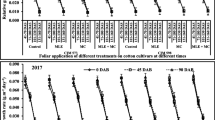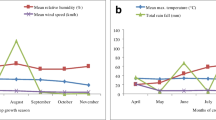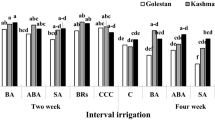Abstract
Foliar spray of growth promoters significantly ameliorated the harmful effects of environmental warming and nutrient deficiency on growth, development and yield of major field crops. So, the current experiment was carried out to evaluate the potential effects of five growth promoting substances, including Moringa leaf extract, Polydol, Multisol, Classic and Asahi star along with water and no spray on growth indices, dry matter assimilation, seed cotton yield and related traits as well as chlorophyll scores of cotton var. MNH-886 under a semi-arid environment of Pakistan. On average bases, the results indicate that exogenous spray of growth promoters enhanced leaf area index by 20.0–26.0%, growth rate by 15.0–21.0%, dry matter partitioning by 15.0–21.0%, sympodial branches by 22.0–33.0%, harvested bolls by 46.0–48.0%, boll weight by 28.0–30.0% and total chlorophyll contents by 15.0–25.0% relative to control treatment. Due to improved morphological and yield contributing traits, the exogenous spray of promoters also increased the seed cotton yield by 21.0–33.0% and net benefit by 50.0–68.0% as compared to control. In conclusion, the MLE, being a cheaper source, could ameliorate the damages imposed by environmental warming and nutrient deficiency, leading to high cotton productivity. The farmers across the world can get high yield of cotton by foliar spray of MLE.






Similar content being viewed by others
References
Abdallah, A. M., & Hanaa, F. Y. M. (2013). Effect of foliar application of some micronutrients and growth regulators on some Egyptian cotton cultivars. Journal of Applied Sciences Research, 9, 3497–3507.
Akram, N. A., & Ashraf, M. (2013). Regulation in plant stress tolerance by a potential plant growth regulator, 5-aminolevulinic acid. Journal of Plant Growth Regulation, 32, 663–679.
Ali, Z., Basra, S. M. A., Munir, H., Mahmood, A., & Yousaf, S. (2011). Mitigation of drought stress in maize by natural and synthetic growth promoters. Journal of Agriculture and Social Sciences, 7, 56–62.
Arif, M., Hussain, N., & Yasmeen, A. (2016). Morphological and physiological response of cotton to exogenous application of growth regulators. Academia Journal of Agricultural Research, 4, 467–477.
Babaeian, M., Tavassoli, A., Ghanbari, A., Esmaeilian, Y., & Fahimifard, M. (2011). Effects of foliar micronutrient application on osmotic adjustments, grain yield and yield components in sunflower (Alstar cultivar) under water stress at three stages. African Journal of Agricultural Research, 6, 1204–1208.
Balakumbahan, R., & Rajamani, K. (2010). Effect of bio-stimulant on growth and yield of senna (Cassia angustifulia var KKM.1). Journal of Horticultural Science and Biotechnology, 2, 16–18.
Bednarz, C. W., Hopper, N. W., & Hickey, M. G. (1998). Effects of foliar fertilization of Texas southern high plains cotton leaf nitrogen and growth parameters. Journal of Production Agriculture, 11, 80–84.
Boyer, J. S. (1982). Plant productivity and environment. Science, 218, 443–448.
Burke, J. J., Mahan, J. R., & Hatfield, J. L. (1988). Crop-specific thermal kinetic windows in relation to wheat and cotton biomass production. Agronomy Journal, 80, 553–556.
Butter, G. S., Aggarwal, N., & Singh, S. (2004). Productivity of American cotton as influenced by sowing date. Haryana Journal of Agronomy, 20, 101–102.
Byerlee, D. (1988). From agronomic data to farmer’s recommendations, an economic training manual (pp. 23–33). Centro International de Maiz Y Trigo.
Deshpande, R.C. (2006). Effect of calmax, a foliar micronutrient fertilizer on growth and yield of hybrid cotton under northern transitional zone of Karnataka. M.Sc. Thesis Dept of Agron College of Agri Dharwad Univ of Agri Sci Dharwad.
dos Reis, S. P., Lima, A. M., & de Souza, C. R. B. (2012). Recent molecular 333 advances on downstream plant responses to abiotic stress. International Journal of Molecular Science, 13, 8628–8647.
Economic survey of Pakistan, (2020). Ministry of Food, Agric. and Livestock, Economic wing, Islamabad, Pak. pp. 18–19.
Farooq, M., Hussain, M., Wahid, A., & Siddique, K. H. M. (2012). Drought Stress in Plants: An overview. In R. Aroca (Ed.), Plant responses to drought stress—from morphological to molecular features (pp. 1–33). Berlin, Germany: Springer.
Farooq, J., Mahmood, K., Akram, M. W., Rehman, A. U., Javaid, M. I., Petrescu-Mag, I. V., & Nawaz, B. (2015). High temperature stress in cotton Gossypium hirsutum L. ELBA Bioflux, 7, 34–44.
Foidle, N., Makkar, H. P. S., & Becker, K. (2001). The potential of Moringa oleifera for agricultural and industrial uses. In L. Fugile (Ed.), The miracle tree: The multipurpose attributes of Moringa (pp. 45–76). CTA publications Wageningen.
Imran, M., Shakeel, A., Azhar, F. M., Farooq, J., Saleem, M. F., Saeed, A., Nazeer, W., Riaz, M., Naeem, M., & Javaid, A. (2012). Combining ability analysis for within-boll yield components in upland cotton (Gossypium hirsutum L.). Genetics and Molecular Research, 11, 2790–2800.
Kumar, K. K. A. (2001). Effect of plant growth regulators on morpho-physiological traits and yield attributes in hybrid cotton (Gossypium hirsutum L.). M.Sc. (Agri.) Thesis, Uni. Agri. Sci. Dharwad.
Malakouti, M. J. (2000). Balanced nutrition of wheat: An approach towards self-sufficiency and enhancement of national health. Ministry of Agriculture.
Marschner, H., Kirkby, E. A., & Cakmak, I. (1996). Effect of mineral nutritional status on shoot-root partitioning of photoassimilates and cycling of mineral nutrients. Journal of Experimental Botany, 47, 1255–1263.
McGraw-Hill, C. (2008). Statistix 8.1. Analytical Software.
Rahman, H. (2006). Number and weight of cotton lint fibres: Variation due to high temperatures in the field. Australian Journal of Agricultural Research, 57, 583–590.
Reddy, S. R. (2004). Principles of crop production—growth regulators and growth analysis (2nd ed.). Kalyani Publishers.
Riaz, M., Farooq, J., Sakhawat, G., Mahmood, A., Sadiq, M. A., & Yaseen, M. (2013). Genotypic variability for root/shoot parameters under water stress in some advance lines of cotton (Gossypium hirsutum L.). Genetics and Molecular Research, 12, 552–561.
Sergiy, P. (2007). Ukranian plant growth regulators from ideato reality. 2nd international symposium plant growth substances: Intercellular hormonal signaling and applying in agriculture. Abstracts session 7: Hormones and synthetic plant growth regulators in agriculture. 8–12 October. Kyiv, Ukraine. pp. 39.
Sharma, C. P., Sharma, P. N., & Chatterjee, C. (1991). Manganese deficiency in maize affects pollen viability. Plant and Soil, 138, 139–142.
Shaukat, M., Ahmad, A., Khaliq, T., Rasul, F., Mudassir, M. A., & Yasin, M. (2017). Inducing drought tolerance in wheat by foliar application of natural and synthetic plant growth promoters under semi-arid environment. Journal of Soil Science and Plant Nutrition, 180, 739–747.
Shukla, K. C., Singh, O. P., & Samaiya, R. K. (1997). Effect of foliar spray of plant growth regulators and nutrient complex on productivity of soybean var. JS 79–81. Crop Research, 13, 213–215.
Siddhuraju, P., & Becker, K. (2003). Antioxidant properties of various solvent extracts of total phenolic constituents from three different agro climatic origins of drumstick tree (Moringa oleifera Lam.) leaves. Journal of Agricultural and Food Chemistry, 51, 2144–2155.
Singh, R. P., Vara, P. P. V., Sunita, K., Giri, S. N., & Reddy, K. R. (2007). Influence of high temperature and breeding for heat tolerance in cotton: A review. Advances in Agronomy, 93, 313–386.
Shah, S. H., & Jabeen, S. (2001). Quantitative and qualitative response of two cotton cultivars to pre-sowing heat stress. International Journal of Agriculture and Biology, 3, 103–104.
Snider, J. L., Oosterhuis, D. M., & Kawakami, E. M. (2011). Diurnal pollen tube growth rate is slowed by high temperature in field-grown Gossypium hirsutum pistils. Journal of Plant Physiology, 168, 441–448.
Steer, B. T., & Hocking, P. J. (1983). Leaf and floret production in sunflower (Helianthus annuus L.) as affected by nitrogen supply. Annals of Botany, 52, 267–277.
Turhan, H., Gül, M. K., Egesel, C. Ö., & Kahriman, F. (2011). Effect of sowing time on grain yield, oil content, and fatty acids in rapeseed (Brassica napus). Turkish Journal of Agriculture and Forestry, 35, 225–234.
Yasmeen, A., Nouman, W., Basra, S. M. A., Wahid, A., Rehman, H., Hussain, N., & Afzal, I. (2014). Morphological and physiological response of tomato (Solanum lycopersicum L.) to natural and synthetic cytokinin sources: A comparative study. Acta Physiologiae Plantarum, 36, 3147–3155.
Zhang, X., Wang, K., & Ervin, E. H. (2010). Optimizing dosages of seaweed extract-based cytokinins and zeatin bioside for improving creeping bentgrass heat tolerance. Crop Science, 50, 316–320.
Zubillaga, M. M., Aristi, J. P., & Lavado, R. S. (2002). Effect of phosphorus and nitrogen fertilization on sunflower (Helianthus annus L) nitrogen uptake and yield. Journal of Agronomy and Crop Science, 188, 267–274.
Author information
Authors and Affiliations
Corresponding author
Ethics declarations
Conflict of Interest
The authors declare that they have no known competing financial interests or personal relationships that could have appeared to influence the work reported in this paper.
Rights and permissions
About this article
Cite this article
Shaukat, M., Ahmad, A., Khaliq, T. et al. Foliar Spray of Natural and Synthetic Plant Growth Promoters Accelerates Growth and Yield of Cotton by Modulating Photosynthetic Pigments. Int. J. Plant Prod. 15, 615–624 (2021). https://doi.org/10.1007/s42106-021-00158-0
Received:
Accepted:
Published:
Issue Date:
DOI: https://doi.org/10.1007/s42106-021-00158-0




